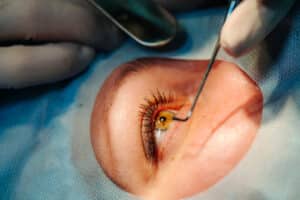 Intralase bladeless LASIK is a revolutionary advancement in vision correction surgery. Unlike traditional LASIK, which uses a bladed instrument called a microkeratome to create the corneal flap, bladeless LASIK utilizes a femtosecond laser to create a precise, custom flap. This technique offers several advantages, including enhanced safety, accuracy, and outcome predictability. Let’s look at how bladeless LASIK works and why it’s a game-changer in refractive surgery.
Intralase bladeless LASIK is a revolutionary advancement in vision correction surgery. Unlike traditional LASIK, which uses a bladed instrument called a microkeratome to create the corneal flap, bladeless LASIK utilizes a femtosecond laser to create a precise, custom flap. This technique offers several advantages, including enhanced safety, accuracy, and outcome predictability. Let’s look at how bladeless LASIK works and why it’s a game-changer in refractive surgery.
What Is Bladeless LASIK?
Bladeless laser eye surgery is a correction procedure that utilizes a femtosecond laser to create the corneal flap instead of a bladed microkeratome. This advanced technology allows for a more precise, custom flap creation, leading to better safety, accuracy, and predictability of outcomes compared to traditional LASIK methods.
How Does Bladeless LASIK Surgery Work?
LASIK surgery involves using a laser to reshape the cornea, enabling it to refract light onto the retina. To access the cornea for reshaping, a small flap is created. In bladeless LASIK surgery, this flap is generated using a laser. Following the reshaping process, the flap is carefully repositioned over the cornea. The flap naturally adheres to the eye tissue, eliminating the need for sutures or another form of attachment.
Advantages of Bladeless LASIK
Sharper Vision
Recent technology advancements have unlocked the potential for achieving sharper and clearer vision compared to previous methods.
Efficiency in Time
The procedure is concise, typically taking just 15 to 20 minutes to complete.
Enhanced Comfort
Patients experience little to no discomfort during or after the procedure, ensuring a comfortable experience from start to finish.
Accelerated Recovery
Recovery time is expedited, with many patients resuming normal activities within 24 hours.
Increased Safety
Bladeless LASIK enhances safety by ensuring uniform thickness of the corneal flap, regardless of the natural curvature of the cornea. This standardized approach greatly reduces the risk of complications associated with flap creation, thus enhancing overall safety.
Eye Conditions That Bladeless LASIK Surgery Treats
1. Myopia (Nearsightedness)
Myopia, or nearsightedness, occurs when the eye focuses light in front of the retina instead of directly on it, resulting in blurred distance vision. Bladeless LASIK reshapes the cornea to correct this refractive error, bringing distant objects into focus.
2. Hyperopia (Farsightedness)
Hyperopia, or farsightedness, is characterized by difficulty focusing on nearby objects due to the eye focusing light behind the retina instead of directly on it. Bladeless LASIK surgery reshapes the cornea to adjust the focal point of light, improving close-up vision.
3. Astigmatism
Astigmatism occurs when the cornea or lens of the eye has an irregular shape, causing blurred or distorted vision at all distances. Bladeless LASIK surgery precisely reshapes the cornea to correct the irregularities, resulting in clearer and sharper vision.
4. Presbyopia
Presbyopia is an age-related condition that affects near vision, making it difficult to focus on close-up objects, particularly when reading or performing tasks at arm’s length. While bladeless LASIK isn’t specifically designed to treat presbyopia, certain techniques—such as monovision LASIK or blended vision LASIK—can address distance and near vision in individuals with presbyopia.
5. Mixed Astigmatism
Mixed astigmatism refers to a combination of nearsightedness and farsightedness with astigmatism. Bladeless LASIK surgery corrects the refractive errors associated with mixed astigmatism by reshaping the cornea to improve distance and near vision.
How Is Bladeless LASIK Different From Traditional LASIK?
| Aspect | Traditional LASIK | Bladeless LASIK |
| Flap Creation | Microkeratome (blade) | Femtosecond laser (bladeless) |
| Flap Thickness | Can vary due to manual technique | Consistently uniform |
| Precision | Dependent on surgeon’s skill | Controlled by computer-guided laser |
| Customization | Limited customization | Highly customizable |
| Safety | Higher risk of flap complications | Lesser risk of flap complications |
| Healing Time | Longer due to manual creation | Faster due to precise, uniform flap |
| Post-Operative Discomfort | May experience more discomfort | May experience less discomfort |
| Recovery Time | Longer downtime | Quicker return to normal activities |
Blade vs. Bladeless LASIK: What’s the Better Option?
 Traditional Blade LASIK
Traditional Blade LASIK
Pros:
- Cost: Traditional LASIK is more cost-effective than bladeless LASIK.
- Experience: Some surgeons have more experience performing traditional LASIK techniques.
- Availability: Traditional LASIK is widely available and has been performed for many years.
Cons:
- Flap Complications: There’s a higher risk of flap-related complications due to the manual creation of the flap with a microkeratome.
- Variable Flap Thickness: Flap thickness can vary, potentially impacting visual outcomes and healing time.
- Post-operative Discomfort: Patients may experience more discomfort and longer recovery times than with bladeless LASIK.
 Bladeless LASIK
Bladeless LASIK
Pros:
- Precision: Bladeless LASIK offers precise flap creation with a femtosecond laser, resulting in uniform flap thickness and enhanced visual outcomes.
- Safety: The risk of flap-related complications is reduced with bladeless LASIK due to its computer-guided, automated process.
- Customization: Bladeless LASIK allows for highly customizable treatments tailored to each patient’s unique eye anatomy and refractive error.
Cons:
- Cost: Bladeless LASIK can be more expensive than traditional LASIK due to the advanced technology involved.
- Learning Curve: Surgeons may require additional training to perform bladeless LASIK effectively.
- Availability: Bladeless LASIK may not be as widely available as traditional LASIK in some areas.
Who is Eligible?
Eligibility for bladeless LASIK surgery is determined through a comprehensive evaluation performed by an experienced ophthalmologist. While specific criteria may vary based on individual circumstances, most candidates must meet the following criteria:
- Age: Candidates should be at least 18 years old, as their vision may still change during adolescence.
- Stable Vision: Candidates should have stable vision for at least 12 to 24 months before surgery with no significant changes in their prescription.
- Refractive Error: Candidates should have common refractive errors such as nearsightedness (myopia), farsightedness (hyperopia), or astigmatism, which can be corrected with LASIK surgery.
- Overall Eye Health: Candidates should have healthy eyes with no active eye diseases, infections, or conditions such as glaucoma, cataracts, or severe dry eye syndrome.
- Corneal Thickness: Candidates should have adequate corneal thickness to safely undergo LASIK surgery. Thinner corneas may not be suitable for the procedure.
- Pupil Size: Candidates with larger pupils may be at higher risk for night vision symptoms such as glare or halos. Technology advancements have made it possible for many patients with larger pupils to be eligible for bladeless LASIK.
- General Health: Candidates should be in good overall health, free from conditions that could affect healing or increase the risk of complications during or after surgery.

Your Trusted Eye Care Specialists
Whether you’re considering bladeless LASIK surgery or seeking comprehensive eye care, our eye experts will help you achieve optimal vision and overall eye health. Don’t let vision concerns hold you back—take the first step towards clearer vision today by scheduling a consultation with Clear Choice Laser. Your journey to better vision starts here.


 Traditional Blade LASIK
Traditional Blade LASIK Bladeless LASIK
Bladeless LASIK










